Today, heating radiators are made of various materials. Classic cast iron is giving way to new, more advanced and practical options. One of them is steel batteries, which will be discussed in this article.
General Provisions
Steel endows heating structures with the following qualities:
Advantages
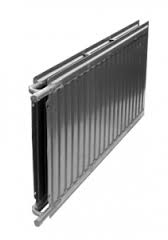
- Affordable price... The described designs are, for example, cheaper than their aluminum counterparts.
- Attractive appearance... They do not need to be hidden behind curtains, covered with furniture or covered with decorative panels. They can themselves serve as part of the interior of your home.

But, of course, it does not do without negative aspects:
disadvantages
- Susceptibility to corrosive processes.
Advice: it is not recommended to use the models in question in buildings with a centralized heating system, from which all the liquid is drained during the summer.
The fact is that damp air further accelerates the appearance and spread of destructive rust.
- Lack of resistance to water hammer.
Advice: you should be equipped with special converters that soften the shock wave of the coolant supply, or not use them at all in high-rise buildings.
Otherwise, water hammer will destroy the entire heating structure in a short time.
- Premature paint peeling.
Tip: It is advisable to use a high quality special paint for steel products.
It will be much more economical than frequent repainting with cheap ones.

Thus, if we compare the characteristics of heating radiators made of steel with models from other materials, it will be possible to conclude that they are ideal for private houses, winning in many ways, and are categorically contraindicated for installation in multi-apartment buildings.
Kinds
There are two types of products in question:
Panel

In the core of such a device are located from one to three sections, consisting of a pair of steel profiles, welded around the perimeter for joining. The plates go through stamping, as a result of which vertical channels appear on them for the passage of the coolant.
To increase productivity, such structures are equipped with additional elements, which determines their division into many types:
| Name | Description |
| Type 10 | Single row model without convector and cladding |
| Type 11 | There is also only one row without the upper grille, but already with a convector |
| Type 20 | Double-row sample with air outlet grill, but without convector |
| Type 21 | Two radiators with a single convector enclosed in a casing |
| Type 22 | Double row radiator, two convectors and a cover |
| Type 30 | Three rows of radiators, no convector fins, a grill on top |
| Type 33 | Three-row model with three convectors and closed casing |

Tubular
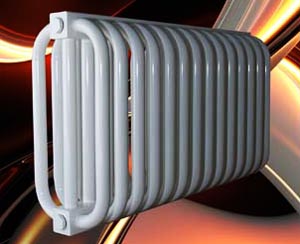
The structure of such a radiator is welded together iron pipes... But it should be noted right away that the final price of such products is very high, and not everyone can afford it.
Parameters
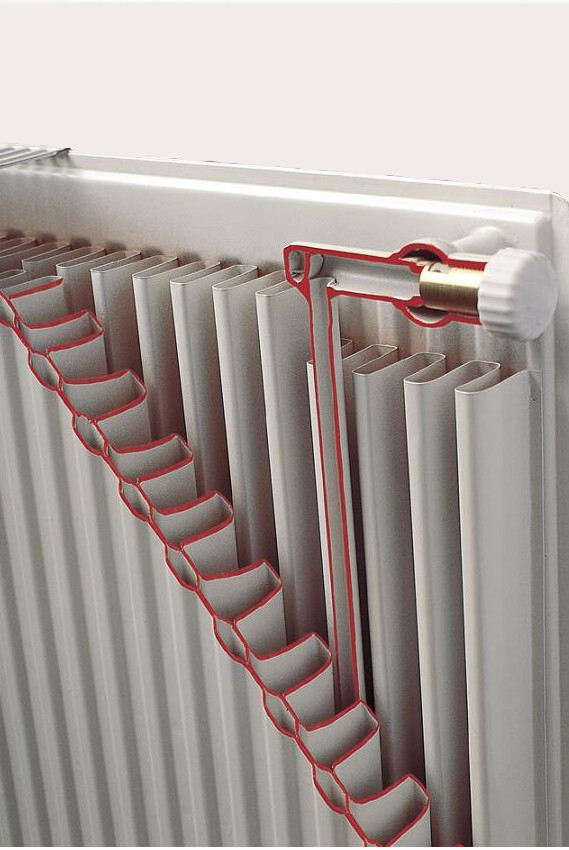
The products under consideration have the following technical characteristics of heating radiators:
| Parameter |
Heating devices are constantly being improved. New models and types are being developed that heat the room more efficiently and can be used in modern interiors. Standard cast iron radiators for heating are less and less common today. They were replaced by other metal heaters. The technical characteristics and appearance of these devices distinguish them favorably from standard batteries.
 Today, on the heating equipment market, the range of metal batteries is very diverse. Thanks to this, you can easily choose an option that is ideal for all parameters and wishes. But in order to know which radiator to choose, you must be able to understand the types of these devices, know their advantages and disadvantages. It is worth noting that before buying metal heating radiators, you should decide on the type and technical characteristics of the device.
Today, on the heating equipment market, the range of metal batteries is very diverse. Thanks to this, you can easily choose an option that is ideal for all parameters and wishes. But in order to know which radiator to choose, you must be able to understand the types of these devices, know their advantages and disadvantages. It is worth noting that before buying metal heating radiators, you should decide on the type and technical characteristics of the device.
Depending on the material, steel, cast iron, aluminum and bimetallic radiators are distinguished. Let's dwell on each of these types in more detail.
Steel batteries
Structurally, the equipment consists of two metal sheets welded together. High strength steel grades are used for production. Such metal heating batteries are efficient and suitable for different operating modes. They are widely used both in city apartments with centralized heating supply and in the private sector in autonomous heating systems. Many well-known brands are made from cold rolled steel with a thickness of 1.25 to 1.75 mm. This allows you to achieve high strength of the finished product.
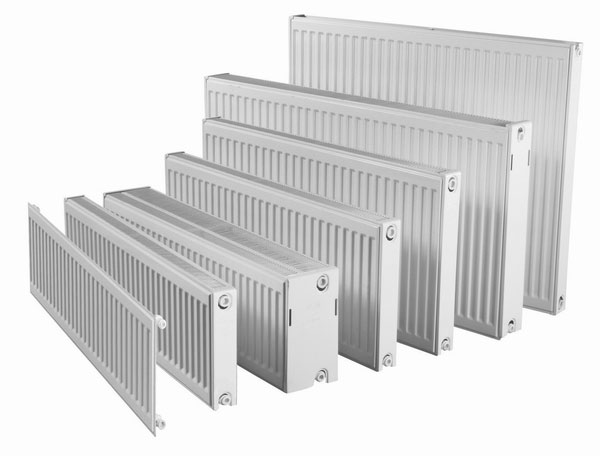 Such metal radiators can be sectional, panel and tubular. Sectional ones are characterized by high strength. Ideal for systems with high working pressure of the heating medium. After all, such a radiator can withstand pressure from 10 to 16 atmospheres. Outwardly, the steel heating battery is somewhat reminiscent of Soviet cast-iron heaters. True, it is more reliable, practical and durable.
Such metal radiators can be sectional, panel and tubular. Sectional ones are characterized by high strength. Ideal for systems with high working pressure of the heating medium. After all, such a radiator can withstand pressure from 10 to 16 atmospheres. Outwardly, the steel heating battery is somewhat reminiscent of Soviet cast-iron heaters. True, it is more reliable, practical and durable.
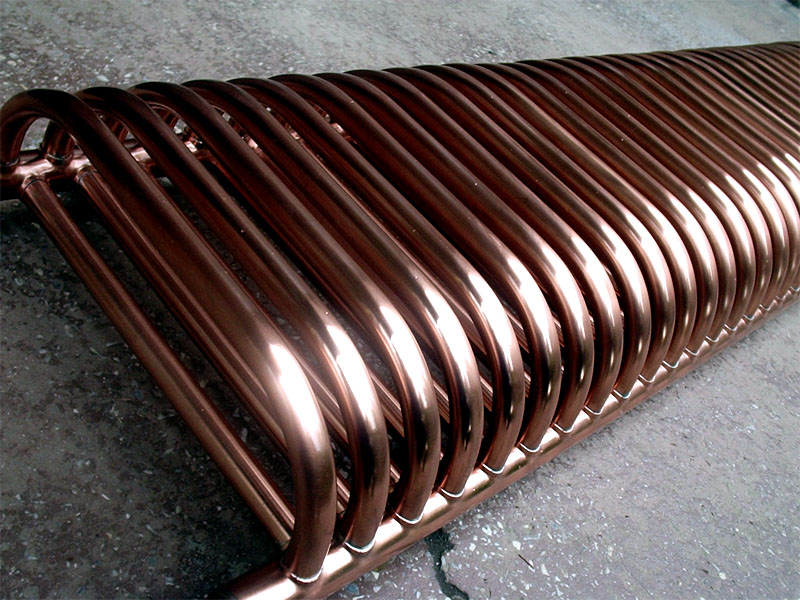 The design of the sectional device consists of several sections welded together. Spot welding is used. It should be noted that technologically this is a rather complicated process. Therefore, the price for such metal radiators is much higher than for other types of steel batteries.
The design of the sectional device consists of several sections welded together. Spot welding is used. It should be noted that technologically this is a rather complicated process. Therefore, the price for such metal radiators is much higher than for other types of steel batteries.
Panel products combine the characteristics of convectors and radiators. These batteries are made in the form of panels.
Flat metal radiators are simple in design.
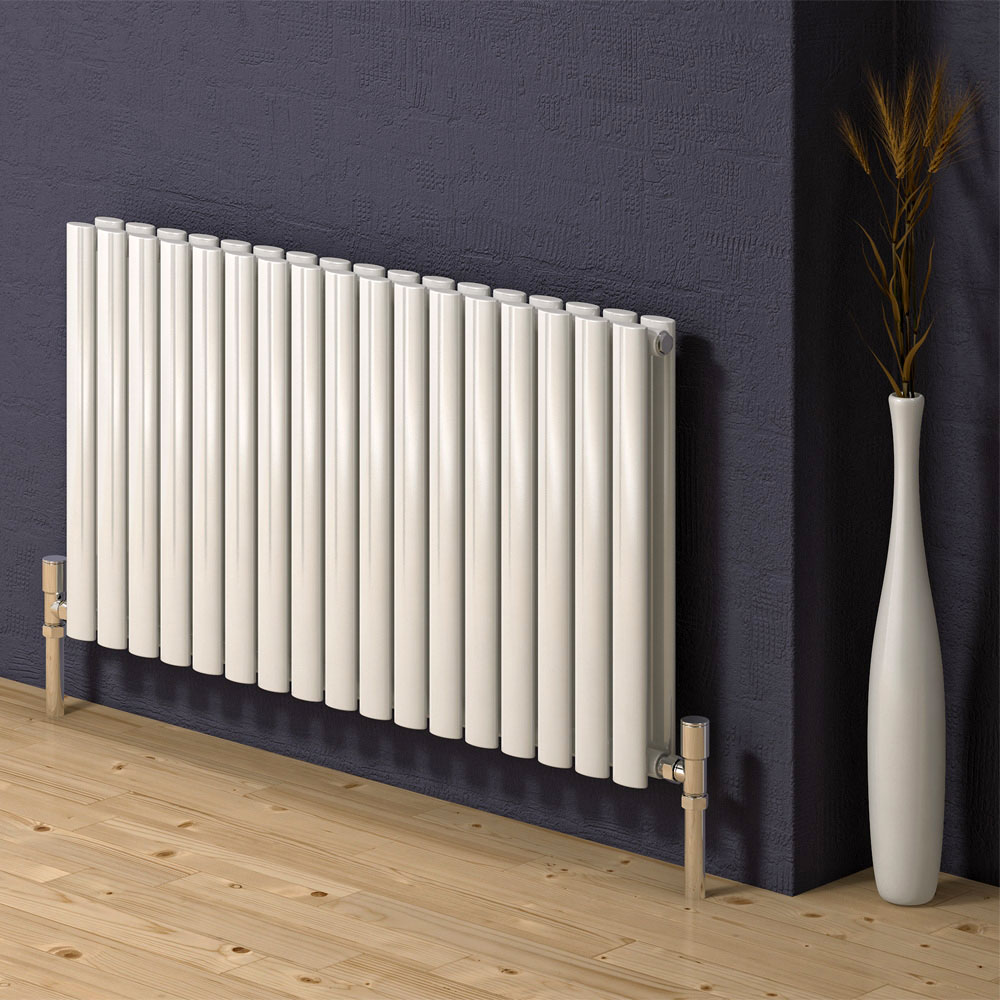 The panel consists of two metal plates with embossed protrusions, which are obtained by stamping. The coolant circulates through vertical channels.
The panel consists of two metal plates with embossed protrusions, which are obtained by stamping. The coolant circulates through vertical channels.
Depending on the number of panels, radiators can be of the following types: 33, 22 and 11. Panel steel radiators type 22 is ideal for small living spaces. These types differ in the number of panels. But it should be noted that for heating radiators steel type 22 prices are higher than for type 11. Since the cost of the battery depends on the number of panels.
Tubular devices are very expensive. And in this regard, they are used much less often. They consist of horizontal and vertical rows of pipes that are connected by manifolds. They are distinguished by high heat transfer. The equipment heats up very quickly. The design can be very different.
All models of steel heaters have the following advantages:
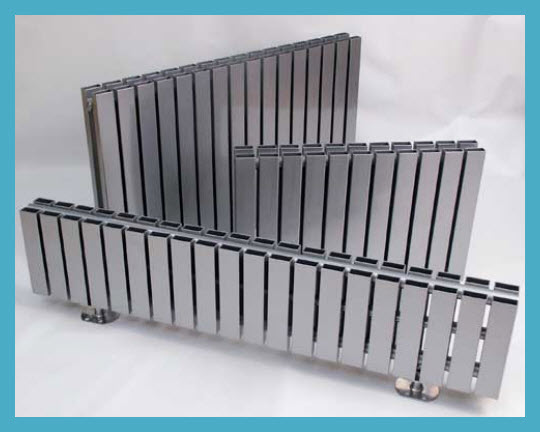
On steel radiators, reviews are mostly positive. But some users also highlight a number of disadvantages. These include the tendency to corrosion, the sensitivity of welds to water hammer. The quality of the paintwork depends on the manufacturer. There are models that can last for decades. And there are devices, the coating of which is quickly destroyed.
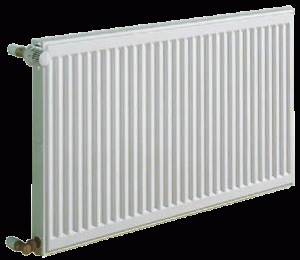 When buying such batteries, it should be borne in mind that the power of steel heating radiators should be selected based on the area of \u200b\u200bthe room, the number of windows, external walls, the presence of double-glazed windows and the insulation performed. To calculate the amount of heat required for a particular room, you need to multiply the radiator power by the area of \u200b\u200bthe heated room.
When buying such batteries, it should be borne in mind that the power of steel heating radiators should be selected based on the area of \u200b\u200bthe room, the number of windows, external walls, the presence of double-glazed windows and the insulation performed. To calculate the amount of heat required for a particular room, you need to multiply the radiator power by the area of \u200b\u200bthe heated room.
Since there are different capacities of steel heating radiators, the thermal power table will help the consumer to make right choice. Each manufacturer has its own table. Of course, the data in it do not differ much, but they still have some discrepancies.
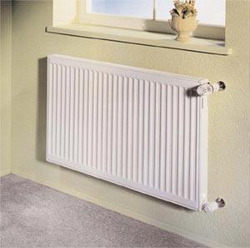 From different countries that produce steel radiators, Turkey takes one of the leading places in the manufacture of devices with an optimal price-quality ratio. Here it is worth highlighting the company Radiatori. The products of this company comply with European standards. The products undergo a rigorous leak test. Therefore, high quality and reliability are guaranteed. Steel user reviews on Turkish heating radiators boil down to the following: high quality, wonderful design and affordable price.
From different countries that produce steel radiators, Turkey takes one of the leading places in the manufacture of devices with an optimal price-quality ratio. Here it is worth highlighting the company Radiatori. The products of this company comply with European standards. The products undergo a rigorous leak test. Therefore, high quality and reliability are guaranteed. Steel user reviews on Turkish heating radiators boil down to the following: high quality, wonderful design and affordable price.
Copper radiators
With regard to the degree of thermal conductivity and heat transfer, copper heating radiators are the leaders. In addition, the advantages of this type of heater include:
The disadvantage of such batteries is one - the price for copper heating radiators is quite high. That slightly limits the widespread use of this type of equipment. But those homeowners who have already installed such batteries do not regret their choice in the least.
The most popular on the domestic market are: Roca, Konner, Ehemet and Nova. The Czech Viadrus styl batteries are also in great demand. The products are distinguished by a fairly affordable price and high quality.
Aluminum batteries
In terms of heat transfer, weight and design, aluminum batteries are superior to steel and cast iron products... True, equipment made from such material has a number of negative characteristics:
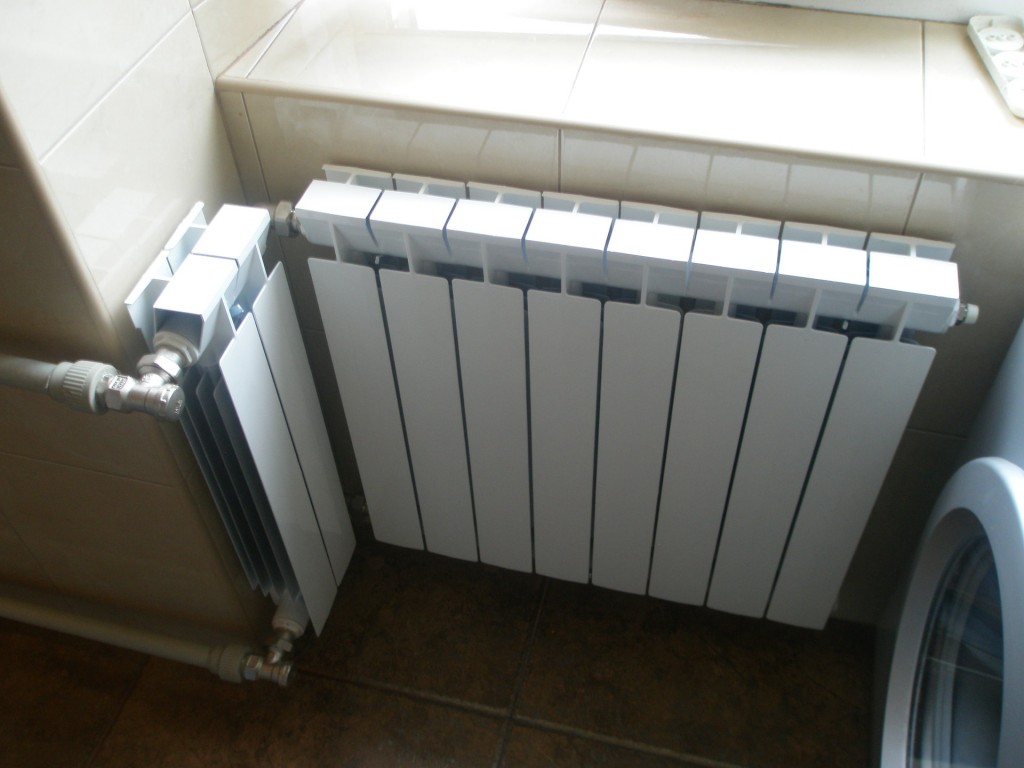
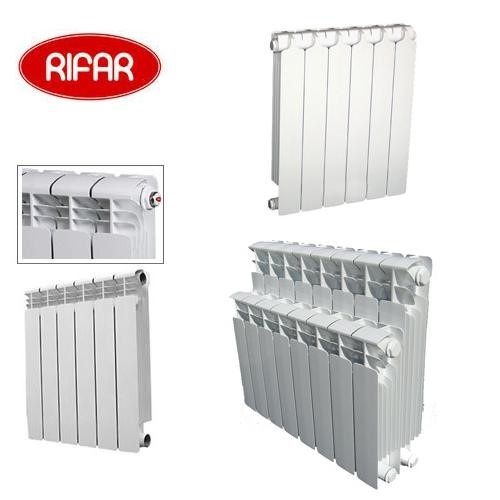 There are several enterprises in Russia that produce aluminum radiators... It is worth highlighting the Ankor plant and the Rifar company. In addition to domestic models, there are also imported products on the market. The highest quality heaters are considered to be from Italy and Hungary.
There are several enterprises in Russia that produce aluminum radiators... It is worth highlighting the Ankor plant and the Rifar company. In addition to domestic models, there are also imported products on the market. The highest quality heaters are considered to be from Italy and Hungary.
There is no definite answer to the question of which company to choose aluminum heating radiators. It all depends on consumer preferences and the size of the budget. Domestic models are cheaper than imported ones, but quality characteristics may be slightly inferior to well-known foreign brands.
Bimetallic batteries
The most practical option for heating apartments multi-storey building are precisely bimetallic batteries. They are made from aluminum and steel. Aluminum fins provide high heat dissipation. And the steel core has good structural strength.
The bimetallic battery has high resistance to water hammer and aggressive environment.
 It can withstand pressure up to 37 atmospheres. Installation is simple, it does not differ much from the installation of a cast iron or aluminum analogue. Externally, bimetallic heaters are very similar to aluminum, but weigh 60% more.
It can withstand pressure up to 37 atmospheres. Installation is simple, it does not differ much from the installation of a cast iron or aluminum analogue. Externally, bimetallic heaters are very similar to aluminum, but weigh 60% more.
If the budget is limited, it is better to opt for an all-metal product. Since the metal price for heating batteries is much more democratic. The most inexpensive bimetal radiators are presented by manufacturers from Russia and China. Chinese products are the cheapest, but of low quality. Among the manufacturers of high-quality bimetallic devices are Italian companies Sira and Global.
 fit perfectly into any interior. Very compact. Heaters are suitable for everyone heating systems... Many models are equipped with a thermostat. That allows you to adjust the heating temperature. The service life of such batteries is long, but when operated with a low-quality coolant, it is significantly reduced.
fit perfectly into any interior. Very compact. Heaters are suitable for everyone heating systems... Many models are equipped with a thermostat. That allows you to adjust the heating temperature. The service life of such batteries is long, but when operated with a low-quality coolant, it is significantly reduced.
Which metal radiator should you choose?
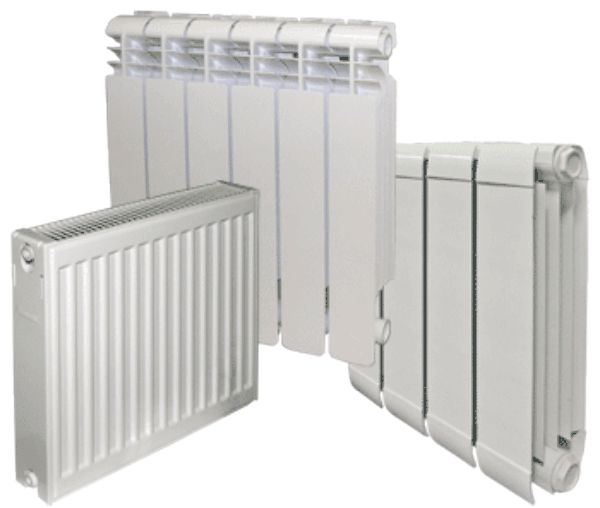 The choice of a heater depends primarily on what is planned to be heated. If this city \u200b\u200bapartment in a high-rise building with centralized heating, it is better to give preference to bimetallic radiators. From the point of view of aesthetics, operational safety and heat transfer, this will be the most optimal solution... But if the budget is limited, then you can purchase steel radiators for heating the room. The strength of such a device is the same as that of a bimetallic one.
The choice of a heater depends primarily on what is planned to be heated. If this city \u200b\u200bapartment in a high-rise building with centralized heating, it is better to give preference to bimetallic radiators. From the point of view of aesthetics, operational safety and heat transfer, this will be the most optimal solution... But if the budget is limited, then you can purchase steel radiators for heating the room. The strength of such a device is the same as that of a bimetallic one.
For the private sector, where heat is supplied through autonomous system, are more suitable. They have excellent heat dissipation. And the price is not high. Temperature and pressure can be adjusted.
Steel panel heating radiators have been developed as an alternative to the old cast iron radiators and have gained the greatest popularity among owners of private houses and cottages. Their main advantage is considered to be a high heat transfer rate, which is much higher than that of sectional type radiators. They are suitable for any premises due to the wide variety of models and options in which panel heating radiators are made. Their technical characteristics are also very good, so they are in constant demand.
Steel panel radiator
Panel radiators consist of several, usually one, two or three panels, which are welded two sheets of steel. After stamping, vertical grooves appear on them, which serve for the circulation of the coolant. To achieve better heat dissipation, they are often equipped with steel fins on the back of the panel to increase air convection.
Batteries are divided into several varieties according to the number of panels:
- type 10 - battery from one panel, without finishing and not equipped with a convector;
- type 11 - a battery from one panel, equipped with one convector, without an upper grill;
- type 20 - a battery of two panels, has an air outlet grill, not equipped with a convector;
- type 21 - a battery of two panels, has one convector, outside it is closed with a casing;
- type 22 - a battery of two panels, has two convectors, a casing;
- type 30 - a battery of three panels, without a convector, covered with a grate on top;
- type 33 - a battery of three panels, with three convectors, closed with a casing.
Important! The heat output depends on the type of radiator. Some, such as types 10 and 11, use heating exclusively, others release heat through heating and convection.
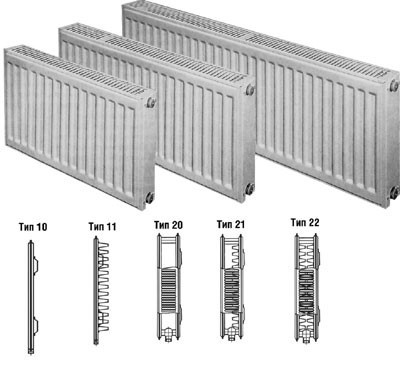
Panel radiator design
In addition, panel radiators are available with bottom and side connection types. Moreover, models with a lower connection type usually have a higher cost due to a more attractive appearance: with this type of connection, the pipes are almost invisible, they go into the floor or plinth without disturbing the appearance of the wall.
Advantages and disadvantages of panel radiators

advantages and disadvantages of radiators
The main reason why people choose steel panel heating radiators is the technical characteristics of this type of battery. They have a number of advantages that distinguish these radiators favorably from other models:
- Simple construction. On the one hand, this can be viewed as an advantage: there is no need to bother with installation by section, because panel radiators are solid. On the other hand, this same quality can be perceived as a disadvantage: in the event of a breakdown, the entire battery will have to be replaced.
- High heat dissipation. A steel panel radiator with unrivaled technical performance in this aspect is perfect for installation in any room. A large indicator of thermal power is achieved due to the properties of steel to quickly receive and give off heat, and in conjunction with the operation of convectors, the result increases many times over. Also, the large surface area of \u200b\u200bthe radiator plays an important role.
- Attractive appearance. Steel panel radiators fit perfectly into any interior without attracting too much attention. With high-quality painting, such batteries can be installed without any decorative panelssignificantly increasing heat loss. The bottom connection also contributes to the overall aesthetics of the radiator.
- Profitability. Not only that, the radiator itself is the cheapest among similar ones. Savings are also realized due to the fact that such batteries need less coolant before heating to the required temperature.
The disadvantages of panel radiators are primarily due to the properties of steel:
- Low corrosion resistance. Steel is easily exposed to chemical attack, so steel panel radiators can be very short-lived if all precautions are not taken.
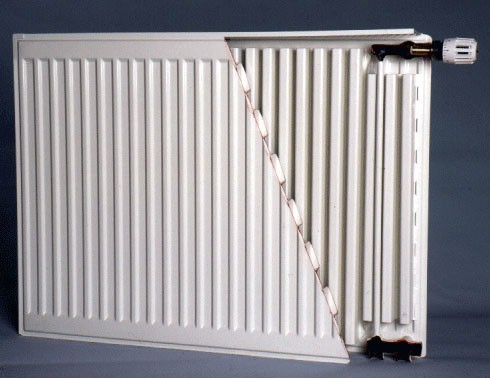
Advantages and disadvantages of panel radiators
Important!When choosing a battery, you need to pay close attention to the quality of the paint. It is the correct paint, applied in compliance with all the rules and regulations, that plays the protective role of the battery.
- Weakness against water hammer. It is worth noting that not only panel radiators, but also most other radiators cannot stand sudden pressure drops in the system. To protect against leaks and damage to the battery, a pressure reducer must be installed.
- Fragility. Due to the nature of the design, it is necessary to avoid any impacts, scratches or similar damage during transportation.
- Inadmissibility of contact of internal surfaces with oxygen. Thus, a steel panel radiator cannot stand without heat carrier for more than two weeks.
Important!Also, do not forget that it is forbidden to install such radiators in the central heating system. They are only suitable for stand-alone systems.
Specifications
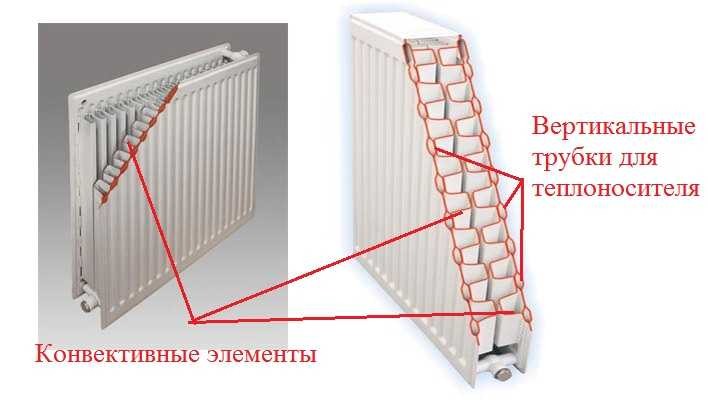
Specifications
To select batteries for a private house the best choice steel panel radiators. Their characteristics differ depending on the specific model, however, general average values \u200b\u200bcan be distinguished:
- working pressure should not exceed 10 bar;
- the maximum allowable pressure in the system is 13 bar;
- the temperature of water or other coolant should not exceed 110 degrees;
- the heat transfer rate fluctuates on average from 1200 to 1800 W, and sometimes reaches large values;
Important!When choosing a panel radiator model, you should definitely consider it heat output, since it cannot be changed in any way, unlike sectional radiators. It is necessary to carry out all the calculations in advance in order to know exactly which battery capacity will cope with the required amount of work.
They are simple devices that have replaced cast iron batteries. Modern panel heating radiators, having metal fins in the middle, increasing heat transfer and equipment efficiency, are used everywhere today.
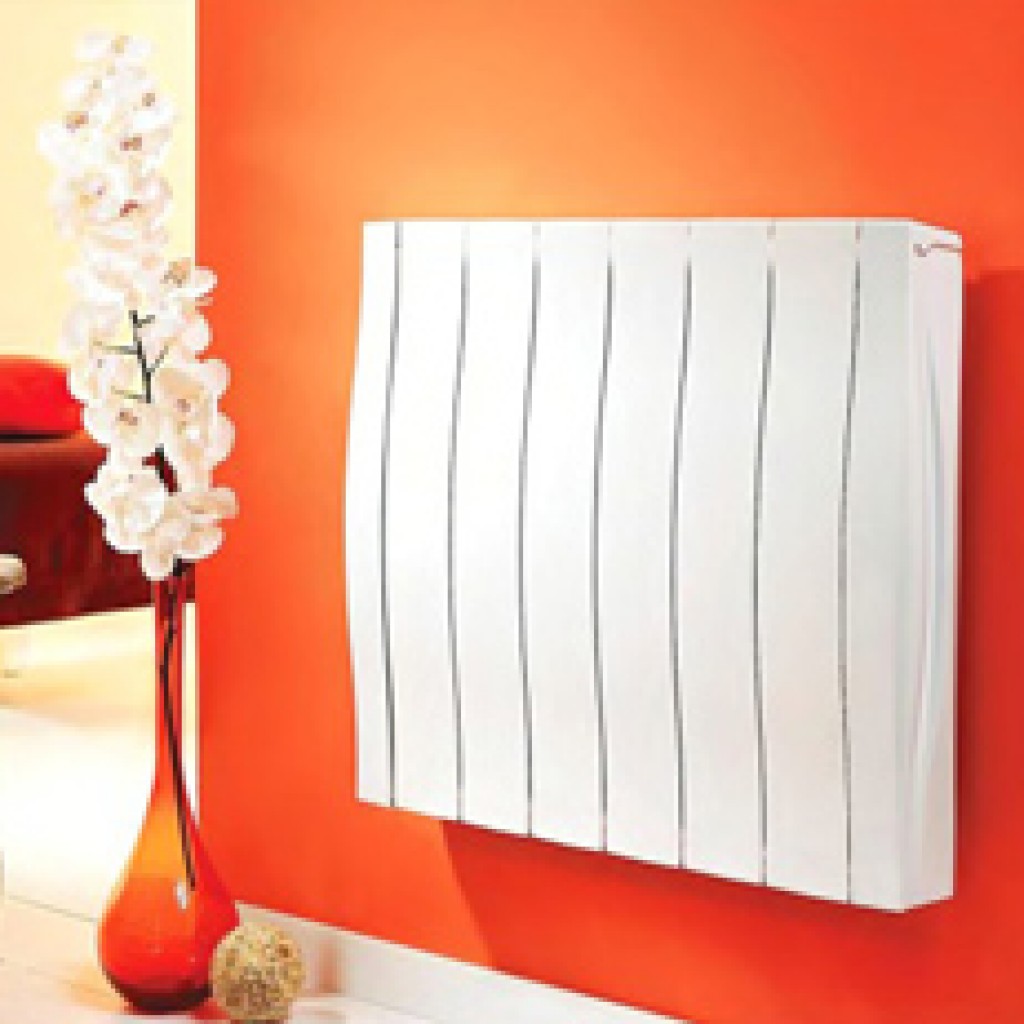 Panel radiators are made of steel. One panel is two sheets, fastened together, with vertically oriented grooves between them, through which water circulates. Ribbed U-shaped projections can be welded to the channels to increase convection. The technical characteristics of a hot water radiator depend on the number of panels and fin lines. Standard sizes are from 400 to 3,000 in width and from 200 to 900 mm in height. The lower part of the case is open, the upper part is protected from foreign objects by a grill. The set includes a valve that regulates the temperature.
Panel radiators are made of steel. One panel is two sheets, fastened together, with vertically oriented grooves between them, through which water circulates. Ribbed U-shaped projections can be welded to the channels to increase convection. The technical characteristics of a hot water radiator depend on the number of panels and fin lines. Standard sizes are from 400 to 3,000 in width and from 200 to 900 mm in height. The lower part of the case is open, the upper part is protected from foreign objects by a grill. The set includes a valve that regulates the temperature.
Heat transfer is carried out due to the constant circulation of a liquid substance (which can be both water and antifreeze) along the heat exchanger. According to reviews, panel batteries work much more efficiently if the area that gives off energy is increased due to the ribs that are located inside the case. When the surface temperature rises, convective air movement occurs, as a result of which the heated part of it rises through the grate, and the cold part enters from below. Additional heating is provided by infrared radiation from the side panels.
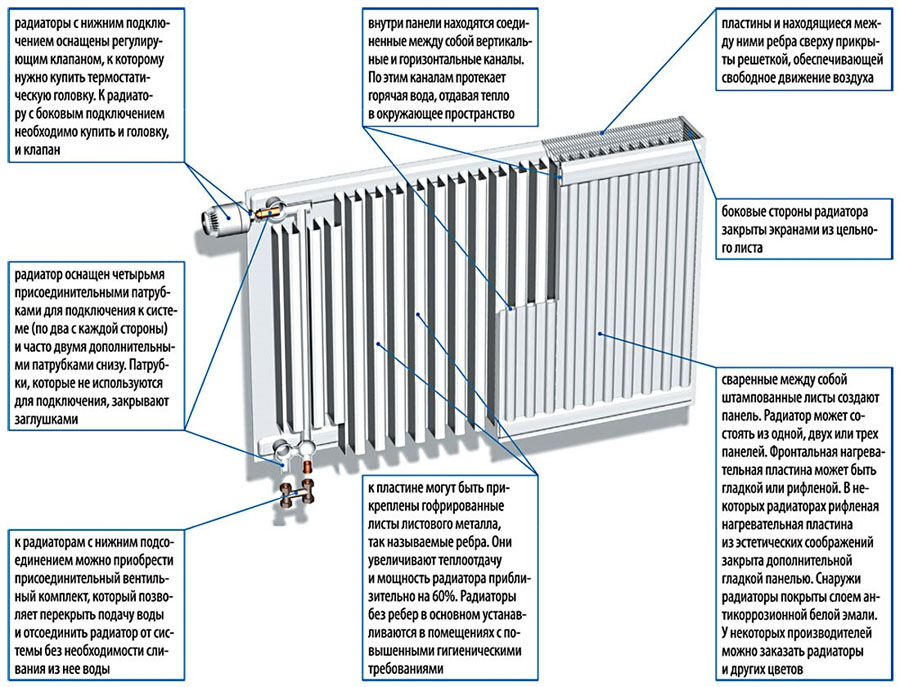
Advantages and disadvantages
There are only three main disadvantages of panel batteries:
- The design features do not allow withstanding pressures exceeding 9-13 atmospheres (depending on the manufacturer), which limits their use in places where the phenomenon of water hammer is excluded. These can be new automated communications or low-rise buildings.
- Steel is a corrosive material. The more often the system is without water, the faster it will fail. The maximum time for which it can be left in this state is two weeks.
- Another inconvenience is the stable pH level of the water, which affects the service life of steel panel radiators. The ideal score is 9 ± 0.5.
As for the advantages, there are much more of them:
- High efficiency.
- Combination of convection and infrared heating methods.
- The ability to adjust the heating power in each individual radiator.
- A small volume of coolant in the system increases the speed of its movement and reduces the cost of heating the fluid.
- A wide range of sizes and types of devices.
- Stylish design and a variety of colors.
- Low price compared to competitive devices.
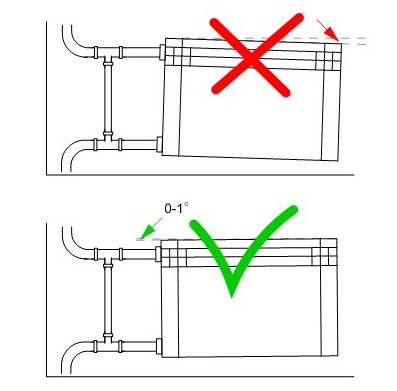
Varieties of panel radiators
Depending on the number of panels and additional fins, radiators are divided into several types. Each of them differs in the level of power and, accordingly, in the price. Let's review panel batteries by their type of design:
- Type 10. Simple and cheap single-row radiators without side baffles and air outlet grille.
- 11. Single row, panel available, a row of convection fins. Starting with this option, the walls and the upper grill appear.
- 20. Two panels without fins to increase heat transfer.
- 21. Two convective surfaces, between which ribbing is located.
- 22. In contrast to the previous one, one more row has been added.
- 33. The most powerful type of panel radiators. Its design includes 3 heating surfaces with ribbed rows.
As you might guess, the first number in the marking indicates the number of convective panels, and the second indicates the presence of ribs that increase the heat transfer of the unit. Additionally, all steel panel radiators are classified according to the way they are connected to the circuit: the first is with a side connection, the second is with the bottom. Since the latter provides a more convenient installation, the cost of this type is higher.
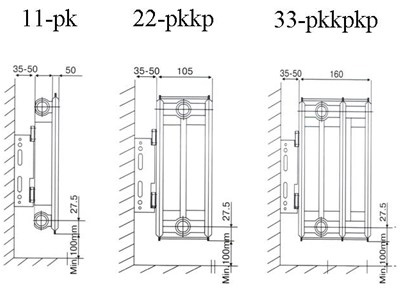
Manufacturers overview
Before deciding, you should familiarize yourself with the description of some of the popular companies on the CIS market.


The nuances of DIY installation
Regardless of the features of sectional and panel batteries, as well as their apparent difference, they are attached according to the same scheme: design-markup-fasteners. At all stages, several important nuances should be taken into account:
- Installation should be carried out in a strictly horizontal position to avoid air accumulation and, consequently, reduce the life of the equipment.
- To increase heat transfer from the radiator, you can pre-stick aluminum foil on the wall behind it.
- From time to time, air enters the structure. To eliminate its accumulations, a Mayevsky tap is inserted into one of the free upper holes of the radiator.
- Removing the packaging is carried out only after installation and checking its serviceability.
- If a radiator is installed in an old system, it is recommended to flush it.
You can buy panel-type water and steam heating radiators in any building supermarket or online store. Estimated cost is shown in the table. The price for installation services is on average 1,500 rubles.
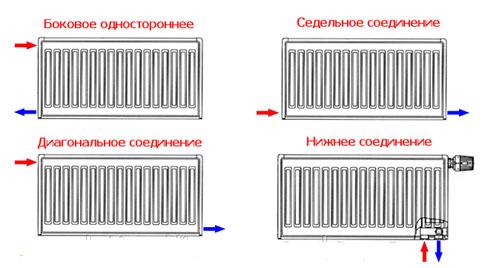
| Manufacturer | Connection | A type | The size | The cost |
| Kermi | Lower | 11 | 500x500 | 2 500 |
| 22 | 500x1000 | 4 600 | ||
| 33 | 600x2000 | 12 000 | ||
| Lateral | 11 | 500x500 | 1 700 | |
| 22 | 500x1000 | 3 600 | ||
| 33 | 600x2000 | 11 900 | ||
| Purmo | Lower | 11 | 500x500 | 2 300 |
| 22 | 500x1000 | 4 900 | ||
| 33 | 600x2000 | 12 000 | ||
| Lateral | 11 | 500x500 | 1 900 | |
| 22 | 500x1000 | 3 900 | ||
| 33 | 600x2000 | 11 100 | ||
| Buderus | Lower | 11 | 500x500 | 4 100 |
| 22 | 500x1000 | 8 100 | ||
| 33 | 600x2000 | 20 200 | ||
| Lateral | 11 | 500x500 | 2 800 | |
| 22 | 500x1000 | 6 700 | ||
| 33 | 600x2000 | 19 800 |
The most important factor influencing the choice of heating devices is the technical characteristics of heating radiators. These characteristics include such indicators as working pressure, pressure test pressure, coolant temperature and other indicators that determine how efficiently a radiator of a particular model will work.
At first glance, it is rather difficult to understand all these indicators, but upon closer examination it turns out that all the technical information is quite understandable. And to make it easier for you to choose a radiator by technical specifications, in this article we will describe in detail the types and features of steel radiators.
Steel heating radiators
Panel type radiators
Steel radiators are of two types:
- Panel radiators.
- Tubular radiators.

Panel-type radiators are heating devicescombining the properties of a convector and a radiator. As a rule, such radiators are produced in the form of rectangular panels of various sizes and thicknesses.
The design of a panel radiator is quite simple:
- The radiator is based on a panel: two steel profiled plates, welded around the perimeter. Inside the panel, by stamping the plates, vertical elongated channels are formed through which the heated coolant circulates.
- To ensure more effective heat transfer can be welded to the panels from the rear U-shaped ribs... The ribs are made of thinner cold rolled steel and provide convective heating of the room.
- Up to three such panels can be included in the design of one radiator. When connecting several panels into one system, manufacturers often cover them with side covers.
- The dimensions of panel-type radiators are very diverse: the height of most models on the market is within 300 - 900 mmand the width from 400 to 3000 mm... The depth of a panel radiator depends on the number of panels, and can reach 170 mm.
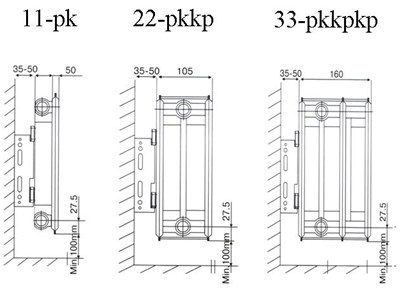
By connection, panel radiators are divided into models with side, bottom and universal connections. As a rule, the price of models with bottom connection is quite high, since very often a thermostat is built into such radiators.
Advice! If your chosen model does not have a built-in thermostat, it can be connected through a special thermostatic valve.
Depending on the model, panel radiators have the following characteristics:
- Working pressure from 6 to 8.5 atmospheres.
- Pressure test no more than 13 atmospheres.
- Heat carrier temperature 110-120 0 С.
Sufficiently low values \u200b\u200bof withstanding pressure testing are the main reason that very often experts do not recommend using steel panel radiators in multi-storey buildings.
Tubular radiators
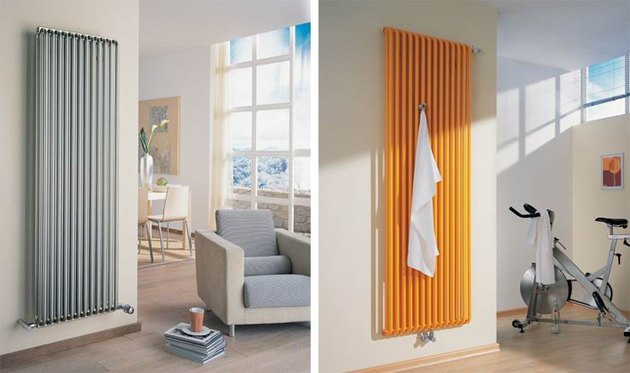
Steel tubular radiators are used somewhat less frequently than panel radiators. The reason for this is the rather high price of tubular devices.
Tubular radiators consist of several rows steel pipes (rows can be both vertical and horizontal) connected to collectors. This design of the radiator makes it very efficient in terms of heat transfer rate: the radiator heats up quickly and cools down quickly under the control of an automatic regulator.
The design of tubular radiators is also very attractive, and sometimes they are even made in the form of interior items (pictured).
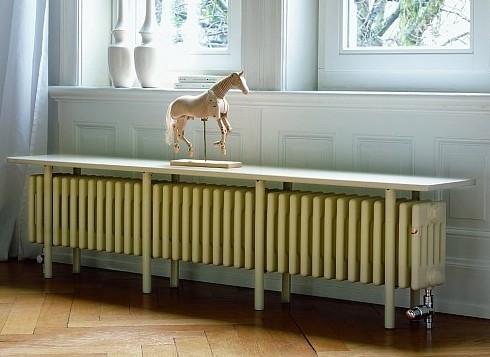
Tubular steel batteries have the following characteristics:
- Product dimensions: height from 190 to 3000 mm, depth up to 225 mm. The length of the tubular radiator is practically unlimited.
Advice! When choosing tubular heating radiators for installation under a window, make sure that their length is at least 75% of the width of the window opening.
- The maximum temperature of the coolant is up to 120 0 С.
- The maximum working pressure is 12 atmospheres.
- Pressing pressure - up to 25 atmospheres.
Due to these characteristics, tubular radiators are an ideal option for installation in city apartments: their design is able to withstand even sufficiently strong water shocks when pressure testing the heating system.
Advantages and Disadvantages of Steel Radiators
Arguments for"
If we compare the performance characteristics of steel radiators with heating radiators made of other materials, then according to some indicators, stainless steel devices look preferable:
- The simplicity of the design of the radiators provides them with a sufficiently long service life. At the same time, high-quality steel heating devices are made of sufficiently thick (1.2 - 1.5 mm) steel, which also has a positive effect on their strength.
- Different design options greatly facilitate the installation of radiators with your own hands. As a rule, each manufacturer's website contains instructions that clearly show how to connect the battery for a particular design of the heating system.

Advice! To be sure that the radiator is connected correctly, we recommend that you watch the video materials attached to the articles in this section.
- Another advantage of steel radiators is their design: such a device will not only heat your apartment, but also decorate it.
Arguments against"
It should be replaced that steel heaters are also not without drawbacks:
- The main disadvantage is the increased tendency to corrosion. Steel radiators are very susceptible to moisture, and if you leave the radiator without water for literally several weeks, the corrosion rate will increase many times over.
- Welds steel radiators (this primarily applies to panel-type devices) are very sensitive to water hammer. When pressing the system, such a radiator can deform or even burst.

- The paintwork of some radiators is also not resistant, so after several years of operation, a poor-quality battery may begin to peel off.
But, even taking into account these shortcomings and analyzing the comparative characteristics of heating radiators, we can state with full responsibility that steel radiators have quite decent performance. And if the conditions in your home and financial capabilities allow you to install such devices, then there is no need to doubt!



